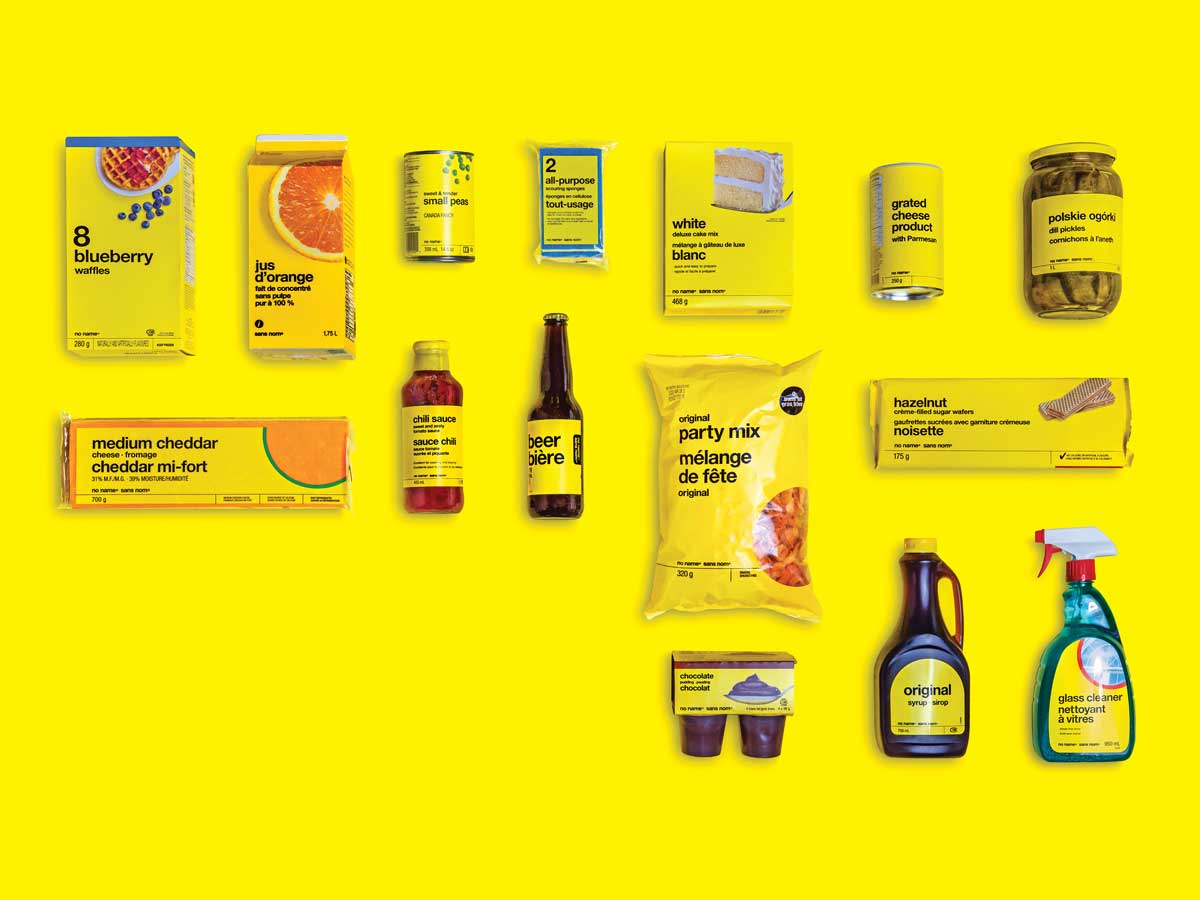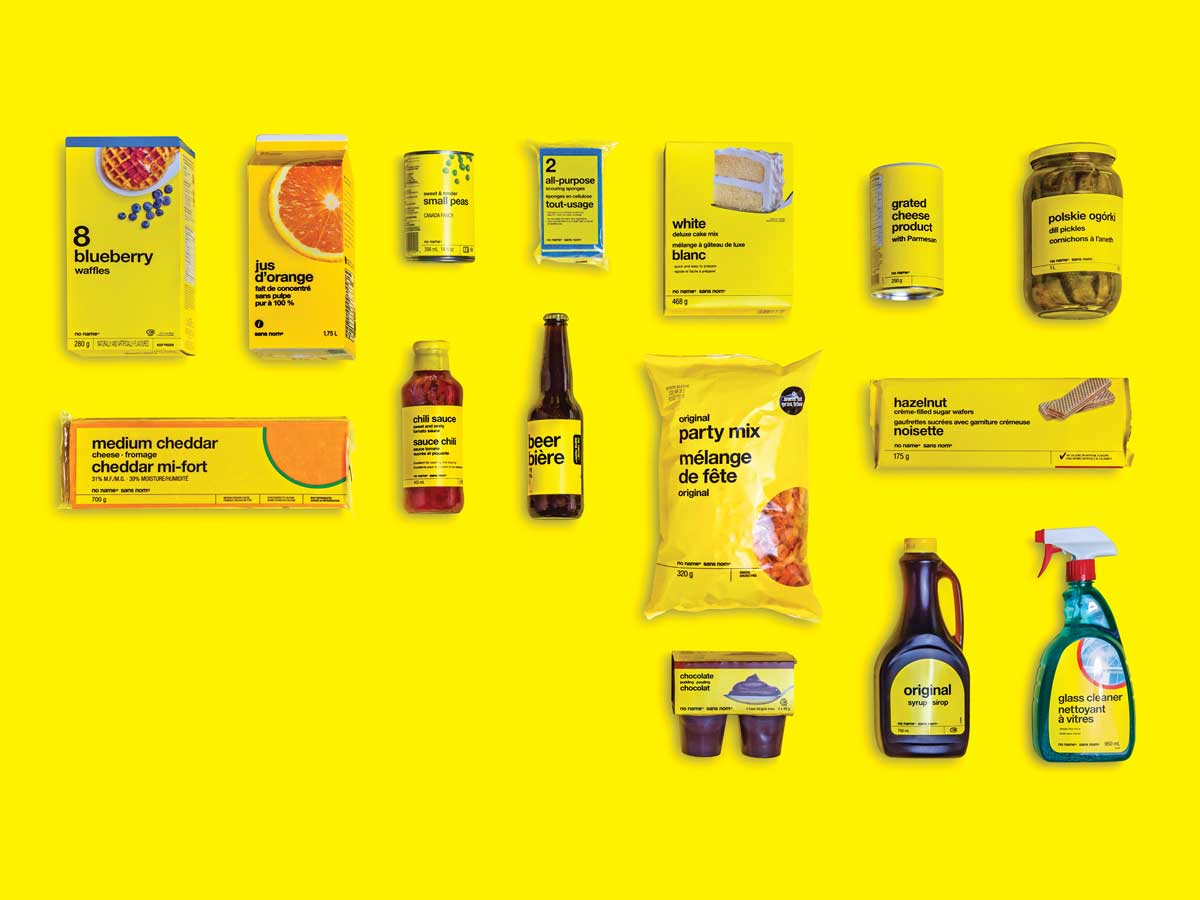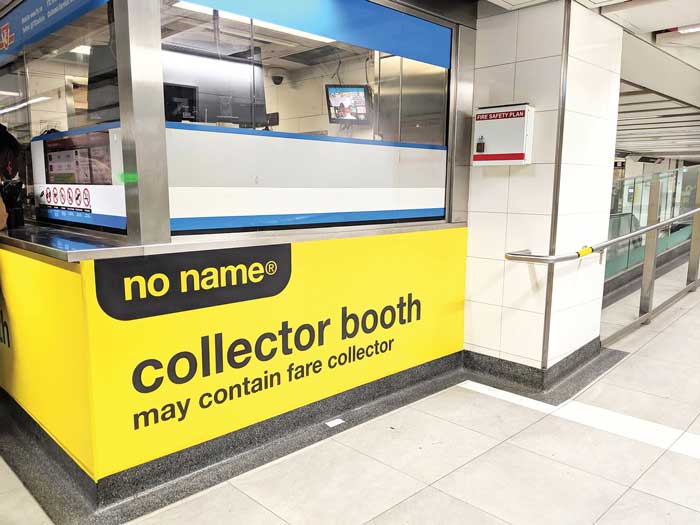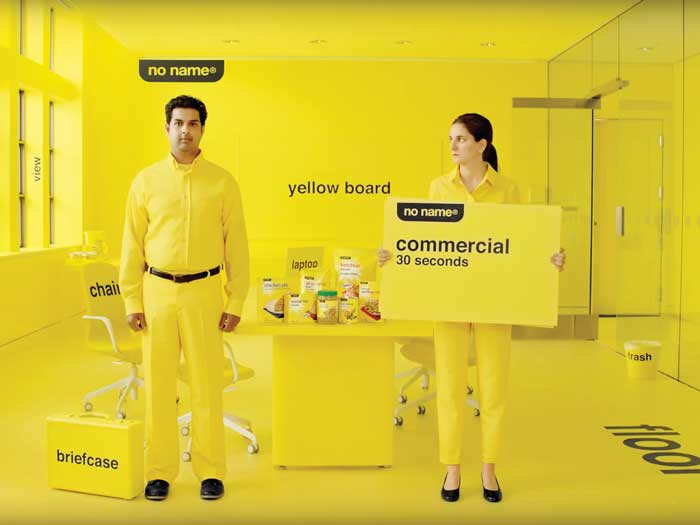
Inside the marketing brilliance of No Name
 In September 2019, Loblaw, in partnership with Toronto advertising firm John St., launched No Name’s first national paid media operation in a decade (Photograph by Daniel Neuhaus)
In September 2019, Loblaw, in partnership with Toronto advertising firm John St., launched No Name’s first national paid media operation in a decade (Photograph by Daniel Neuhaus)
The tweet for baking powder reads “will not replace oven.” A slab of medium cheddar’s message is “cannot communicate with the other side.” The dispatch for a box of 80 “mountain fresh” fabric softener sheets clarifies, “80 sheets not mountains,” and prepared yellow mustard gets the disclaimer “not available in other colours”—true to the No Name brand’s thrifty ethos. And on goes the deadpan No Name Twitter feed, releasing pictures of familiar products with pithy sayings, often setting off hundreds of retweets and thousands of likes. That’s quite a feat for a line of discount products—and a testament to Canadians’ affection for the Loblaw Companies Ltd. budget brand.
The tweets are part of a recent effort to get Canadians talking about a brand that’s been omnipresent for over 40 years. In September 2019, Loblaw, in partnership with Toronto advertising firm John St., launched No Name’s first national paid media operation in a decade with a series of TV and online ads—the largest campaign spend in the brand’s history, and the biggest national campaign for No Name in 30 years. That same month, the grocer took over parts of Toronto’s Bloor-Yonge and Union subway stations and plastered them in No Name-branded posters. Commuters were greeted with bright yellow signs declaring “subway platform with assorted commuters and trains,” “stairs for going up” and, at the subway entrance, a No Name collector booth that “may contain fare collector.” Torontonians began spotting banana-yellow taxis (“seats four people and one driver”) and even a No Name-wrapped building on hip Queen Street West (“may contain people”). When Loblaw released a line of No Name merchandise on Black Friday, T-shirts that read “shirt with long sleeves” sold out almost immediately.
No Frills has typically eschewed grabby advertising campaigns—after all, that would be a frill. But the ads are part of a three-year-old campaign to “re-energize” the brand. Uwe Stueckmann, Loblaw’s senior vice-president of marketing, explained that the company was hoping to capitalize on customers’ changing attitudes toward discount shopping. According to a report put out that year by Boston Consulting Group, discount grocers have grown at a steady clip since 2000. Globally, the report found, discounters were projected to increase their number of store locations by 4.4 per cent each year through 2020, compared to 2.9 per cent for their mainstream counterparts and 1.6 per cent for superstores. The study credited millennials with much of this growth: people in their late 20s and 30s prefer discount grocers, and the aggregate spending power of this slice of the population in large developed markets—275 million people worldwide—dwarfs that of every other demographic segment.
 Toronto’s Union subway station (Photograph by Karon Liu)
Toronto’s Union subway station (Photograph by Karon Liu)
That might explain the No Name print ads resembling concert posters, or the No Frills retro 8-bit-style online video game, introduced in the spring of 2019, called “Hauler: Aisles of Glory.” This tongue-in-cheek strategy has caught the attention of bemused social media users, who have helped spread the word on Twitter and Instagram. But, as Marty Weintraub, Deloitte Canada partner and national retail leader, points out, brand loyalty in this area is fickle. It’s one thing to delight harried commuters on their way home, but will that endearment translate to increased sales? After all, Weintraub says, in the grocery business, “A can of beans is a can of beans.”
No Name’s ubiquity can’t be overstated. The brand’s transport trucks ply Canadian highways, and around 260 No Frills stores dot the country, all kitted out in the same yellow background and black Helvetica type as the No Name products found on their shelves. The look was created by the late, legendary Canadian graphic designer Don Watt, who was hired by Galen Weston Sr. in 1973 to reinvigorate then-struggling Loblaw. He designed the No Name look as well as the more upmarket President’s Choice brand and was widely credited with turning the ailing business around. Watt, whose clients included Walmart, Safeway and Home Depot, pioneered the idea of a whole system of store branding, with uniform colours and fonts on house brands, signage, promotional flyers and interior design.
Loblaw launched No Name in 1978, with the first No Frills store opening in Toronto that year. “We have always believed that there’s a latent inherent love for this super, hyper-Canadian brand,” says Dave Wotherspoon, the creative director of Loblaw Companies. “There are private label brands and then there are private label brands. No Name is one of those ones that people don’t think of as being private label. No Name is thought of as a capital-B Brand.” Forty-two years later, it’s as strong a part of the Canadian retail landscape as Tim Hortons or Canadian Tire.
“It definitely is one of those brands that people love,” says brand strategist Eli Singer, CEO of NearNow, a consulting firm based in Toronto. “They swear by it. It saves them a ton of money and they feel smart. They feel people shopping elsewhere who are paying 30, 50 or 200 per cent more for the same product are foolish. It’s a customer base that has got a lot of pride.” Singer says the No Name brand is so strong that it becomes part of a customer’s identity and creates a sense of community. “That’s very fertile territory from a brand perspective,” he says, but the cheeky Twitter campaign is not without risk. “You don’t want to alienate your customers,” he says.
Weintraub points out that house brands are quite strong in Canada. “Different companies approach it slightly differently, but everyone has a private label program,” he says. “Some may be doing better than others in terms of product assortment, price value, perception, but they’re important and a big contributor to margin.” For the past several years, according to Nielsen Canada, private label brands—such as Selection (Metro) and Compliments (Sobeys)—have been gaining market share faster than national brands.
According to Boston Consulting Group, the discount grocery market in North America is still relatively incipient, particularly compared to entrenched markets in Norway, Germany and Denmark. But the firm’s report singles out No Frills as a successful example of a leading grocery store spinning off into the discount space—even as it acknowledges the spotty track record of such a strategy.
This success isn’t just due to the number at the bottom of your receipt. “In differentiation, it’s no longer just about price,” Weintraub says, “so there’s a growing focus on innovation.” One such innovation from No Name is Simple Check, a new line of products launched in the fall of 2019 that are free of 10 undesirable ingredients, such as artificial flavours or sweeteners, synthetic colouring and monosodium glutamate (MSG). Simple Check responds to an increasing demand for healthier food, even at the discount level.
The Simple Check products were launched in tandem with the wider marketing push. “As No Name develops new products and introduces Simple Check, there was an opportunity to reset the conversation and try something new,” says Wotherspoon, the man behind the tweets. The ongoing Twitter campaign is notable because an established brand has embraced a sense of humour and a deep level of customer interaction. But there are still some creative rules to follow.
 A scene from a No Name TV and digital ad (Photograph by Daniel Neuhaus)
A scene from a No Name TV and digital ad (Photograph by Daniel Neuhaus)
“We can’t lie, or tell something that isn’t true,” says Wotherspoon. “Like medium cheddar. No, it cannot communicate with the other side, playing on the word ‘medium.’ It’s not a lie, but maybe it’s a bit more information than you need.” The tweets, he adds, follow a strict format: “They’re always lower case and fewer than six words. It’s very simple.” Wotherspoon works with a small five-person team and he finds he’s always thinking about the @NoNameBrands account. “I must say, it’s interrupted my shopping trips because I can’t just go to the store without an ‘Oh, wait a minute’ moment,” he says. “The process is very organic.”
Social media is new territory for most grocery retailers. “It’s still relatively nascent,” says Weintraub. “The big battle that grocers are working through is, how do they become hyper-personalized and develop a one-to-one relationship with the shopper or consumer? They’re still very attached to the good old weekly flyer. We’re starting to see some budging from old-school paper marketing to a data and analytically informed digital marketing focus. That’s the trend.”
That one-to-one relationship has flourished with the No Name Twitter campaign. The company is taciturn about the results of the promotion, but the beauty of a social media campaign is that it provides head-on evidence of interaction: the @NoNameBrands Twitter handle has over 46,000 followers as of press time, more than double the Loblaws account.
“In no other platform have I seen such an incredible direct conversation with the customer,” says Wotherspoon. “We can hear what they think. We’ve had literally hundreds of people dressed up like No Name for Halloween and we even supported them with a tweet by making a sticker they could print out and put on their shirt that says ‘costume.’ ” When the Canadian indie rock band Arkells interacted with @NoNameBrands on Twitter in September—the Twitter handle had taken it upon itself to live-tweet the Emmys—suddenly the band’s followers were talking about No Name. The following night, actor and comedian John Hodgman praised one of No Name’s Emmy-related tweets to his more than one million Twitter followers, unleashing more celebrity shine onto the brand.
 A building on Toronto’s Queen Street West (Photograph by @eclaidley/twitter)
A building on Toronto’s Queen Street West (Photograph by @eclaidley/twitter)
Singer, the brand strategist, was impressed by how No Name approached Lido Pimienta, the Colombian-Canadian recording artist who won the Polaris Music Prize in 2017. Pimienta has not shied away from speaking about the sometimes negative experiences of being an immigrant and an artist of colour in Canada. On Twitter she was recounting how she did a fashion shoot for Toronto Life magazine at the No Frills located in the Dufferin Mall in Toronto’s west side. She called it “the happiest place on earth” and said she’d like to have a release party there for her new album. No Frills responded with, “Hi Lido! We may be able to help. Shoot us a DM [direct message] and we can chat.” For a brand, there’s a certain amount of risk associated with interacting with an artist who might not respond the way marketers would like. “I thought that was wonderful,” says Singer. “It’s really incredible and edgy but also true to their loyal customers.”
But customers are not entirely predictable. Weintraub points out that in the grocery business, the names of the stores can blur together for patrons fixated on convenience and value. “To stay relevant, you have to be extremely customer-focused and know them,” he says. “Years ago in food retailing, we talked about picking your spot. On any end of the spectrum, grocers got stuck trying to be everything to everyone—what I used to lovingly refer to as being stuck in the mushy middle. You never want to be stuck in the mushy middle in any business.”
Singer, a No Frills customer himself, was a fan of Loblaw’s “Hauler” campaign, a series of social media posts and TV commercials that showed a variety of No Name customers proudly “hauling” their purchases home. “If you look at some of the individuals in those original videos,” Singer says, “there were people of all different backgrounds, ages, shapes and sizes.” But the irony-soaked, deadpan side of the campaign gave him pause. “When I started seeing all the stuff at the subway station, I thought it was a bit of a turnoff. Where’s the community in this? Is the value of No Name the fact that it’s yellow, or is the value of the brand the humanity in it, the people who are making the decision to shop there?”
He points out that in the marketing world, the tremendous cost of station domination—i.e., taking over an entire subway station—is just about the biggest frill of them all. No Name, then, is walking an interesting line as it differentiates itself between the viral coolness of celebrity and localized individual encounters on social media, and being a brand that its customers hold close to their hearts—a brand that, as Wotherspoon put it, makes people feel like it “has their back.”
That’s one multifaceted can of No Name beans.
Watt this wayCanadian designer Don Watt established his first firm, Don Watt + Associates, in 1966. In the ensuing decades before his death in 2009, Watt was responsible for a host of instantly recognizable branding schemes. Here’s a selection of his most iconic designs. |
|---|
Home Depot Watt worked with the founders of Home Depot to create the Atlanta-based hardware store’s famous orange-and-white logo and store concept in 1978. Walmart The U.S. mega-retailer launched its premium private label, Sam’s Choice, in 1991. Two years later, the store followed it up with the discount in-house brand Great Value. Metro When Metro Inc. acquired A&P Canada’s stores in 2005, Watt was hired to design Metro’s new stores as well as Quebec’s Super C grocery chain. His firm also helped develop Metro’s in-house brands, Irresistibles and Selection. Loblaws In 1973, Watt landed his first deal to overhaul the Loblaws grocery chain, which led to his work on the No Name brand later that decade. In 1986, he created the President’s Choice brand. Nestlé With his design for Nescafé instant coffee in the 1960s, Watt was widely credited with being the first to use photo-symbolism on packaging. |